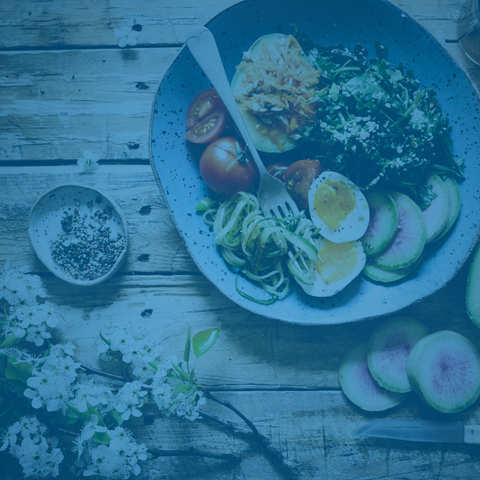
Imagine opening a menu, but instead of choosing for yourself, you are ordering for trillions of tiny guests living inside you. These microbial diners, also known as your gut bacteria, do not just consume what you eat; they translate your food choices into chemical messages that influence your digestion, immune function, mood, and even sleep [1,2]. One of the most fascinating outcomes of this interaction is the production of gamma-aminobutyric acid (GABA), a neurotransmitter essential for calming the nervous system and regulating stress.
GABA is often discussed in the context of the brain, but it's also synthesized in the gut: both by your own cells and by specific gut microbes. You can read more about GABA production via gut microbiota here. Understanding how dietary choices influence GABA synthesis at the microbial level opens up new possibilities for enhancing emotional wellness, resilience to stress, and even improving sleep quality through nutrition.
Unfortunately, modern diets that are high in ultra-processed products and low in fiber undermine this process. They reduce microbial diversity, disrupt beneficial pathways, and impair the microbiota’s capacity to synthesise compounds like GABA [3,4].
This article explores how specific dietary factors: fiber, micronutrients, fermented foods, and timing, can support microbial GABA production and overall gut-brain health. Let’s dive into what your microbiota needs to feed your calm.
You Are What You Feed. Literally.
Every time you eat, you are not just feeding yourself; you are feeding an entire microbial community in your intestines. And these little gourmands respond fast. Research indicates that within 24 hours of a significant dietary change, the composition of gut bacteria undergoes noticeable shifts [5]. This makes diet one of the most powerful levers for altering your microbiome [6] and potentially influencing GABA production through both nutrient and microbial pathways.
So, what is the favorite entrée for beneficial gut bacteria?
Fiber. Humans cannot digest fiber on our own, but our gut bugs thrive on it, fermenting fibers from vegetables, fruits, legumes, and whole grains into beneficial compounds like short-chain fatty acids. These compounds help keep our gut lining strong and inflammation in check. Feeding our good bacteria fiber essentially nourishes them with their favorite food, and in return, they work hard to keep us healthy: microbiota-accessible carbohydrates are fermented into short-chain fatty acids like butyrate, which support colon health and may indirectly influence neurotransmitter systems like GABA by maintaining intestinal barrier integrity [7].
Dietary Factors That Promote GABA Synthesis
GABA is not only produced in the central nervous system but also synthesized locally in the gut. This process depends on dietary components that serve as precursors and enzymatic cofactors, as well as on the activity of specific gut microbes.
The primary biochemical pathway for GABA synthesis involves the decarboxylation of glutamate by the enzyme glutamate decarboxylase (GAD), which requires vitamin B6 as a cofactor. Glutamate is abundantly present in foods such as tomatoes, soy, mushrooms, and bone broth, while vitamin B6 is found in chickpeas, bananas, and tuna. Without adequate B6, this enzymatic conversion is significantly impaired [1,5].
Other micronutrients also support GABAergic function. Magnesium plays a regulatory role in GABA receptor activity, and zinc contributes to synaptic signaling and neuronal modulation. These minerals are available in foods like leafy greens, almonds, and shellfish [1].
In parallel, specific members of the gut microbiota, particularly strains from the Lactobacillus and Bifidobacterium genera, can produce GABA directly from dietary glutamate. This microbial production occurs via the gadB/gadC gene pathway and has been demonstrated in both laboratory and human-derived strains [3]. Fermented foods such as kimchi, miso, yogurt, and kombucha are rich in these GABA-producing microbes and may contribute to gut-brain signalling [1,4].
Although dietary GABA itself has limited ability to cross the blood-brain barrier, emerging evidence suggests that GABA produced in the gut (either by your own cells or by beneficial microbes) may still influence mood, inflammation, and brain activity. This communication likely occurs through signals sent via the gut–brain connection, including the vagus nerve, which acts as a key messenger between your digestive system and your brain [2,4,6].
Microbial Red Flags
- Ultra-processed foods: Often stripped of fiber and packed with additives, these can lower microbial diversity and encourage harmful bacteria.
- Excess sugars: Empty calories for you and a feast for less desirable microbes that can crowd out beneficial bacteria.
- Emulsifiers and additives: Common in processed foods, these can disturb the gut lining and microbiome [8].
Meals, Microbes, and the Clock
It is not just what you feed your microbes: when you feed them matters too. Your gut microbiome has a daily rhythm. Certain bacterial groups bloom when you eat and then subside during fasting periods. Constant snacking or late-night meals can disrupt these rhythms.
Researchers have found that erratic meal schedules or late-night eating can throw the gut microbiota off balance [9]. Studies report that nighttime junk food or alcohol can reduce levels of helpful bacteria and increase inflammation. Over time, this microbial jet lag may contribute to weight gain and metabolic issues such as insulin resistance [10].
Conversely, aligning meals with the body’s clock can boost microbiome health. Time-restricted eating (limiting meals to a consistent window) helps beneficial species flourish. Overnight, during the fasting period, certain bacteria switch to repair mode, strengthening the gut lining and producing gut-healing fatty acids [11].
Clean Isn’t Always Healthy
While hygiene is important, overly sterilizing our diet can backfire. For most of human history, people ate foods teeming with microbes: from soil to fermentation. Today, much of our food is sterilized and ultra-processed, leaving few microbial exposures to support gut health.
Early and varied exposure to environmental microbes (e.g., from fresh produce, soil, animals) is thought to play a role in training the immune system and building resilience. This supports the "old friends" hypothesis: that some microbes historically co-evolved with humans and their absence in modern life may contribute to rising immune-related disorders. This idea underpins the value of raw foods carrying commensal (non-pathogenic) microbes.
Fermented foods like yogurt, kefir, kimchi, and sauerkraut are rich in live microbes. Adding these foods can increase diversity and even reduce inflammation [12]. Raw fruits and vegetables, when properly rinsed, can carry helpful microbes from the environment.
One Size Doesn’t Feed All
The optimal menu for your microbiome may not be the same as someone else’s. Each person harbors a different microbial balance. This means individuals can respond differently to the same foods.
Emerging research shows that personalized nutrition informed by microbiome testing can help tailor diets for optimal health. For example, one person’s blood sugar might spike with bananas, another’s with cookies, depending on their gut microbes [13].
Listening to your body and introducing fiber-rich foods gradually is key. The microbiome adapts and evolves, and fine-tuning your diet based on your gut’s responses may yield the best results.
Closing Thoughts: Plating the Perfect Microbial Menu
The evidence is clear: your gut microbiome responds rapidly and measurably to dietary choices. Within a day, significant shifts in microbial populations can occur based on what you eat [5]. Over time, those choices can support or erode the diversity and resilience of your gut ecosystem, influencing everything from immune health to metabolic balance [3,14].
A diverse, fiber-rich diet supports short-chain fatty acid production, reduces intestinal permeability, promotes anti-inflammatory pathways, and GABA production [7,11]. In contrast, diets dominated by ultra-processed foods, added sugars, and emulsifiers are associated with dysbiosis, inflammation, and a greater risk of metabolic and immune dysfunction [8].
As the science around personalized nutrition advances, one takeaway remains consistent: foundational dietary principles such as plant diversity, whole foods, regular meal timing, and fermented foods offer measurable benefits for gut health across populations [12,13].
This is not about trends or elimination diets. It is about consistency, variety, and supporting a microbial ecosystem that thrives when nourished properly. By focusing on the dietary elements that enhance GABA synthesis, such as glutamate-rich foods, key micronutrients, and fermented products, we can help shape a gut environment that promotes calm, resilience, and balance.
Every plate is an opportunity to influence your microbiome. And your microbiome, in turn, helps shape your health.
Bon appétit, for you, and your trillion tiny dinner guests.
References
- Arponen S. ¡Es la microbiota, idiota! Vergara; 2021.
- Felice, D., Cryan, J. F., & O'Leary, O. F. (2022). GABAB Receptors: Anxiety and Mood Disorders. Current topics in behavioral neurosciences, 52, 241–265. https://doi.org/10.1007/7854_2020_171
- Yunes RA, Poluektova EU, Dyachkova MS, et al. GABA production and structure of gadB/gadC genes in Lactobacillus and Bifidobacterium strains from human microbiota. Anaerobe. 2016;42:197-204. doi:10.1016/j.anaerobe.2016.10.011
- Gut Microbiota for Health. World Microbiome Day 2024: The knowns and unknowns of the gut microbiome and personalized nutrition. 2024.
- Reuell P. Your gut’s what you eat, too. Harvard Gazette. 2014.
- Courage KH. Fiber-Famished Gut Microbes Linked to Poor Health. Scientific American. 2015.
- Sonnenburg ED, Sonnenburg JL. Starving our microbial self: the deleterious consequences of a diet deficient in microbiota-accessible carbohydrates. Cell Metab. 2014;20(5):779-786. doi:10.1016/j.cmet.2014.07.003
- Chassaing B, Koren O, Goodrich JK, et al. Dietary emulsifiers impact the mouse gut microbiota promoting colitis and metabolic syndrome. Nature. 2015;519(7541):92-96. doi:10.1038/nature14232
- Thaiss CA, Levy M, Korem T, et al. Microbiota Diurnal Rhythmicity Programs Host Transcriptome Oscillations. Cell. 2016;167(6):1495-1510.e12. doi:10.1016/j.cell.2016.11.003
- Zarrinpar A, Chaix A, Xu ZZ, et al. Antibiotic-induced microbiome depletion alters metabolic homeostasis by affecting gut signaling and colonic metabolism. Nat Commun. 2018;9(1):2872. Published 2018 Jul 20. doi:10.1038/s41467-018-05336-9
- Patterson E, Ryan PM, Cryan JF, et al. Gut microbiota, obesity and diabetes. Postgrad Med J. 2016;92(1087):286-300. doi:10.1136/postgradmedj-2015-133285
- Wastyk HC, Fragiadakis GK, Perelman D, et al. Gut-microbiota-targeted diets modulate human immune status. Cell. 2021;184(16):4137-4153.e14. doi:10.1016/j.cell.2021.06.019
- Zeevi D, Korem T, Zmora N, et al. Personalized Nutrition by Prediction of Glycemic Responses. Cell. 2015;163(5):1079-1094. doi:10.1016/j.cell.2015.11.001
- Martínez I, Perdicaro DJ, Brown AW, et al. Diet-induced alterations of host cholesterol metabolism are likely to affect the gut microbiota composition in hamsters. Appl Environ Microbiol. 2013;79(2):516-524. doi:10.1128/AEM.03046-12





Comments (0)
There are no comments for this article. Be the first one to leave a message!